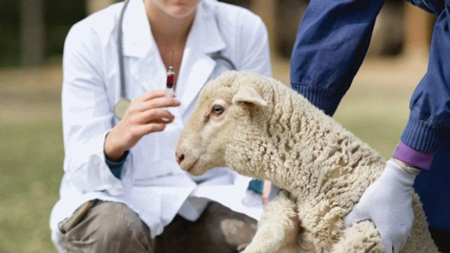Spanish sheep study finds vaccine aluminum in lymph nodes more than a year after injection, behavioural changes
Lambs injected with vaccines and a key ingredient in many vaccines develop numerous pouches of the toxic metal that spread around their body for at least 15 months and induce behaviour changes, long after the shot, according to a study published in November 2018 by Spanish veterinary researchers.

Lluís Luján and researchers at the University of Zaragosa divided 78 male lambs into three groups – one receiving an accelerated vaccine schedule for sheep of 19 injections over 15 months, one receiving aluminum salts commonly added to vaccines to provoke an immune response and one group receiving a saline control.
Universal reaction
The study reported that numerous granulomas – cheese-like blobs ranging from 0.5 cm in diameter to 2.0 cm in diameter in the tissue under their skin which migrated to the sheep’s lymph nodes and persisted in their bodies for the duration of the 15-month experiment – were a “universal reaction” in sheep injected with both aluminum adjuvant and vaccines.
The animals who were vaccinated developed more nodules which were more prominent than those which received aluminum adjuvant alone suggesting that commercial vaccine preparations evoke different immune responses than their aluminum ingredients alone. “Remarkably, seven of the vaccine lambs (26.9% of the group) showed between 13 and 16 nodules in the right flank” samples of tissue drawn at the end of the experiment when the animals were sacrificed.
When the researchers examined the tissue samples microscopically, the granulomas were found to be composed largely of macrophages – white blood cells that travel throughout the body scouring up pathogens – that were loaded with tiny dagger-like shards. These fragments were identified by special staining to be aluminum metal at levels more than 85 times the level found in samples from control lambs. They were found to clump together in jagged aggregates which the researchers linked to other research that has found.
Jagged edges
Other researchers have speculated that the jagged edges of aluminum engulfed in macrophages act like a Japanese throwing stars which puncture sacs inside the macrophages and spill out into the cell activating its programmed cell death pathways. That appears to be what Luján’s team saw: areas where sacs inside the macrophages showed “discontinuity and loss, leading to the presence of free intracytoplasmic spiculated material.” This material invaded areas of apparent cell death and contained the same needle-like shards as well as other materials including carbon, lead, copper and osmium — a byproduct of the staining reaction used in the experiment.
Aluminum is well established as a neurotoxin and its use in vaccines is highly contested by leading aluminum researchers even though public health agencies have insisted it is used in quantities insufficient to cause harm. In humans it has been linked to neurological diseases including Macrophagic Myofasciitis and in provoking a wide range of autoimmune diseases.
Ovine ASIA
Luján first published research on aluminum toxicity in sheep when he discovered that a new and bizarre disease which decimated the Spanish sheep industry in 2009 was in fact caused by a compulsory blue tongue vaccine campaign. His team published a study demonstrating that the disease known as ovine Autoimmune/Inflammatory Syndrome Induced by Adjuvants (ASIA) can be experimentally induced by injection of vaccines containing aluminum and aluminum concentrates in damaged nervous tissue.
Systemic signs
“Local translocation of [aluminum] may induce further accumulation in distant tissues and be related to the appearance of systemic signs,” the current study says.
These “systemic signs” are alluded to as wool-biting and restlessness, two key symptoms of fatal ovine ASIA which increased as the “cumulative number of injections increased”. Wool-biting is seen an anxious or aggressive behaviour among sheep which is unexplained in the veterinary literature to date and is a noted symptom of the ASIA syndrome which is marked by bizarre behavioral changes, animal disorientation, convulsions, weight loss and death and which still routinely affects vaccinated sheep in Spain today.
“This experiment was part of a comprehensive study to improve understanding of the ovine ASIA syndrome, and it has been successful in reproducing some, but not all, of its most remarkable changes,” the researchers said. “Treatment groups also showed higher levels of stress biomarkers, and the clinicopathological picture as a whole showed few significant differences between these groups.” These results, the researchers promise, are to be published in detail elsewhere.
yogaesoteric
May 11, 2019
Also available in:
 Français
Français
